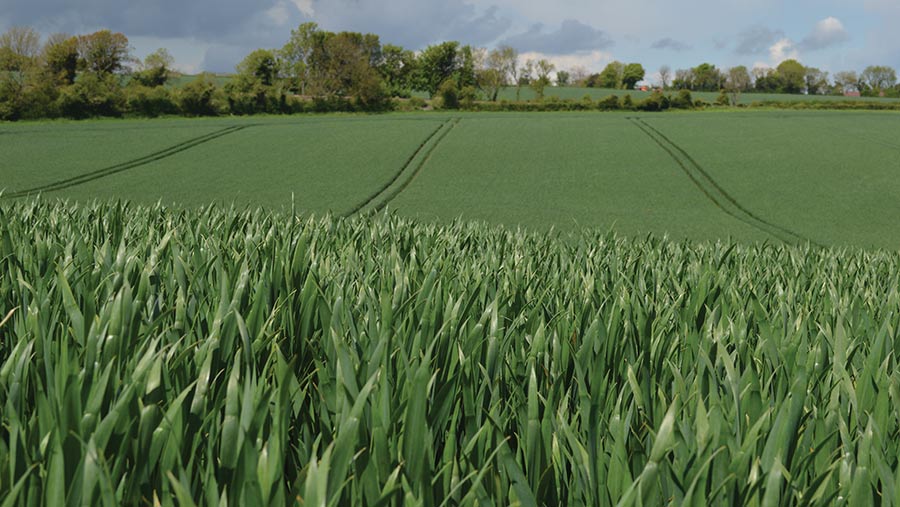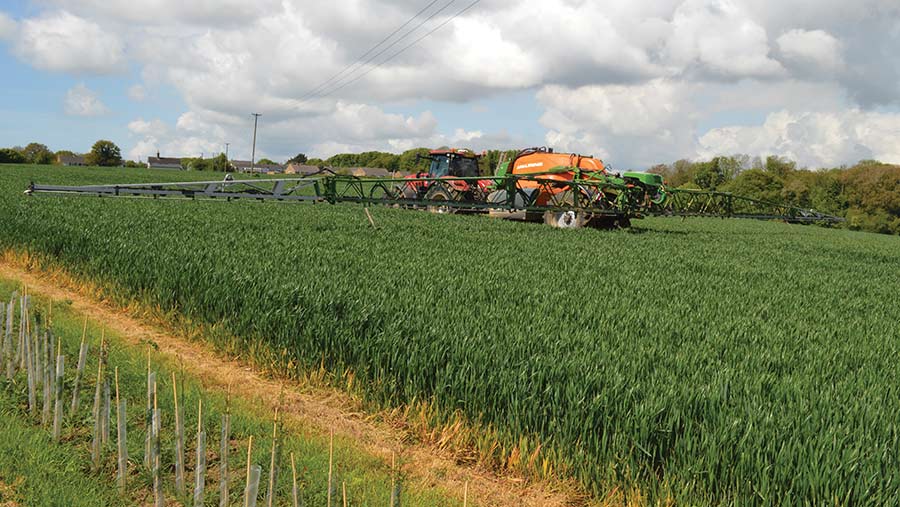Protein test sees Kent milling wheats hit breadmakers’ needs
 © MAG/David Jones
© MAG/David Jones Kent farm manager Jack Woolley is using a grain protein prediction test to help him meet milling wheat protein requirements and so use valuable nitrogen fertiliser as efficiently as possible and protect the environment.
He uses the test in mid-June to assess whether he needs to apply a liquid nitrogen top-up on the ears of his wheat crops to make sure his breadmaking varieties meet the 13% protein content most of the industry demands.
See also: Nitrogen and soil focus helps Norfolk grower win wheat prize
The Velcourt manager, based in east Kent, has hit milling specifications over the last three seasons when using the test across the 300ha of breadmaking varieties he is growing on chalk-based soils just inland from the White Cliffs of Dover.
“We are looking at reducing the risk of not getting the milling premium, while taking into account the cost of nitrogen fertiliser and minimising the environmental impact of the fertiliser,” he tells Farmers Weekly.

Jack Woolley © MAG/David Jones
Wheat budget
He budgets for an average milling wheat yield of 11t/ha at 13% protein, and last season yields averaged 11.75t/ha with proteins over 13.2% across all his milling wheats, with the variety Crusoe often grown as a first wheat and Skyfall a second.
Velcourt had sometimes struggled to meet milling wheat proteins on this unit, and now sees this as the first useful test to solve what was seen by many as the holy grail of milling wheat production – being able to calculate just the right amount of nitrogen needed to meet milling specifications.
The farming group is now using the prediction test over the 3,600ha of milling wheat it grows on the 56,000ha it farms across the UK, with the cost of the test being £32.50/sample.
The test was devised by Mechteld Blake-Kalff at the independent laboratory Hill Court Farm Research which analyses the roots of the wheat plants rather than take a sample of leaves or young grain, and has proved successful with wheat growers.
Three solid splits
This season, Jack has already applied 270kg/ha of nitrogen in three splits, so will take 10 plant samples across his milling wheat fields in mid-June and look for results within a week as to whether he should apply a further 30kg/ha of nitrogen in liquid form on the wheat ear.
Last season, in the dry spring and early summer his eight results from the test predicted protein levels at 12.1-12.2%, and so it was worth spending an extra £60/ha on 30kg/ha of liquid nitrogen Nufol (20%).
Nick Anderson, the group’s head of crop technology, says the foliar urea product when applied at the milky ripe stage (GS71) is likely to show an increase in grain protein content of about 1%.
He adds that 60 separate tests by the company over the past three years have shown the test to be accurate to within 0.4% of grain protein, which is sufficiently accurate to help guide whether or not to apply foliar urea.
Key advantages
He sees three key advantages. Firstly, if the protein prediction test comes back with a low reading, of say 10-11% protein, it will be a waste of money to apply Nufol and the crop should go as feed wheat.
Secondly, it allows Velcourt to manage wheats to be within 1% of the 13% target and then it can top up. Thirdly, in the rare cases when the predicted protein is well above 13% then it can hold back and save on nitrogen.
This season the winter wheats at the four farms which the group manages from Martin Lodge Farm, Martin Mill, just north of Dover, were largely drilled in the first week of October.
In January, soils were analysed with a soil nitrogen supply plus (SNS-plus) test to ascertain three values – nitrogen in the soil, nitrogen in the growing crop and finally nitrogen likely to be mineralised through the growing season.
“An accurate understanding of SNS is the starting point for good nitrogen fertiliser decisions,” says Nick.
The wheat crops of Crusoe and Skyfall received 70kg/ha of solid urea at the end of February, then 100kg/ha of liquid urea-ammonium nitrate (UAN) in mid- to late March, and finally 100kg/ha of solid ammonium nitrogen in mid- to late April.
There was no application of nitrogen at the traditional flag-leaf timing in May.

A T2 fungicide spray being applied on May 11 © MAG/David Jones
Nitrogen spread
The spread of nitrogen types is to fit in with farm workloads on the sprayer or fertiliser spreader, and the ability of the crops to take up the different forms at different times of the year.
“Work with YEN has shown that crop biomass has been a limiting factor in some cases, especially during recent dry early spring conditions.
We have found that sufficient early applications have helped to reduce this risk,” adds Nick. The Yield Enhancement Network (YEN) is a yield competition run by crop consultants Adas.
The farm is achieving more than 65% nitrogen use efficiency with its wheat crops, which it calculates as nitrogen removed (grain nitrogen multiplied by yield) divided by total nitrogen inputs (SNS-plus applied nitrogen) multiplied by 100.
Fungicide regimes are devised to counter Skyfall’s susceptibility to yellow rust and that of Crusoe to brown rust.
Skyfall receives a T0 of the azole tebuconazole and a T1 of Elatus Era (SDHI benzovindiflupyr + azole prothioconazole) plus multisite folpet and a T2 of Univoq (picolinamide fenpicoxamid + prothioconazole).
Crusoe has no T0, and a T1 and T2 both of Revystar (SDHI fluxapyroxad plus azole mefentrifluconazole) plus folpet. T3 sprays have yet to be confirmed.
Protein prediction test
Dr Blake-Kalff says her laboratory tested about 500 samples last season and says that most growers who use the test come back every season due to the accuracy of the results.
“The beauty of the test is that you can sample through the month of June and then be able to adjust a final fertiliser application to make up any potential protein shortfall identified, or cut out the application and save money if the predicted protein is sufficient,” she says.
Her initial work had focused on testing wheat leaves for sugar content, which accumulates if there is insufficient nitrogen from the protein. Unfortunately, results varied depending on how sunny the weather was at the time of sampling, so the focus then switched to the roots, and how much nitrogen is being taken up from the soil.
Examination of cleaned wheat roots gives a very accurate indication whether the rest of the plant has enough nitrogen to produce the required protein in the grain.
With the samples being taken six-to-eight weeks before harvest, there is still a need for good sunlight levels and therefore good photosynthesis for the added nitrogen to be assembled into protein, she adds.
“We cannot control the weather conditions, but by getting the nitrogen supply right we give ourselves the best chance to achieve milling specification,” adds Dr Blake-Kalff.
Traditional breadmaking standards |
|
| Protein content | 13% (Warburton 12.5%) |
| Hagberg | 250 (Warburton 225) |
| Specific weight | 76kg/hl |
Further details of the protein prediction test can be obtained from Hill Court Farm Research, info@hillcourtresearch.co.uk or telephone 0300 303 8088.

